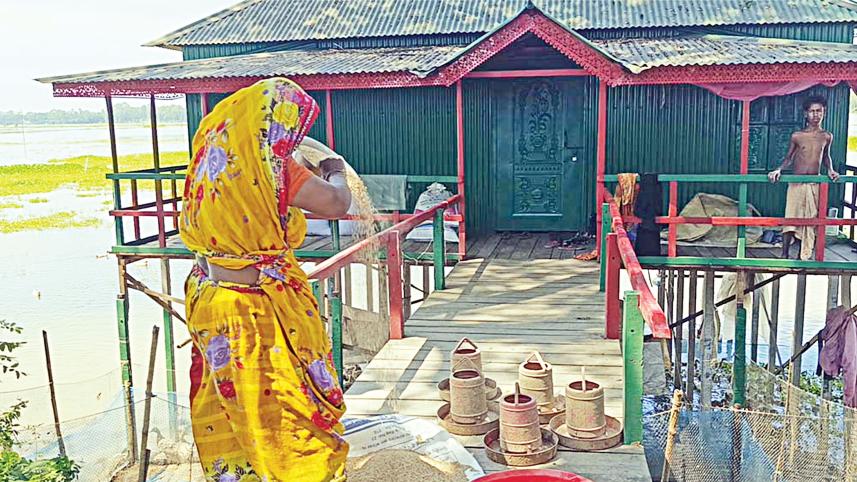How duck farming reshaped Chalan Beel’s economy

When monsoon waters from surrounding rivers pour into Chalan Beel, the vast wetland once famed as the "House of Fish" comes alive. For generations, fishing in the wet season and field farming in the dry season sustained its people. In recent decades, thousands of ducks have joined the ecosystem, gliding across the waters in their flocks, lifting people out of poverty and reshaping the economy.
For many families who could no longer live off fish or paddy, ducks have become the new lifeline. Once a full-time housewife, Momeena Khatun of Sirajganj's Naogaon village under Tarash upazila is a prime example.
A couple of decades ago, her family was fully dependent on field farming. The flowing water made it impossible to work for about five to six months a year. Poverty lingered until she bought 30 ducks.
"The profit was so good that I expanded my farm with 100 ducks in my second year. Now I have over 1,000 ducks in Chalan Beel at Mannan Nagar," she said. "We can easily earn a minimum of Tk 30,000 from each 1,000 ducks if we get full production."
Khatun is now considered one of the region's top success stories in duck farming. She is not alone. Over the past two decades, more than 200 duck farms have appeared across Chalan Beel, which spans multiple districts.
According to district livestock offices, about 25 lakh ducks are raised in Pabna, Natore and Sirajganj, though the real figure is likely higher since small family farms often go unrecorded.

Most farms are set up in Tarash and Ullapara upazilas of Sirajganj; Chatmohar and Vangura in Pabna; and Gurudashpur, Boraigram, and Singra upazilas of Natore. Sirajganj leads in numbers, with over 13.26 lakh ducks.
"The vast wetland provides ample food and a favourable environment for ducks to grow, turning the farms incredibly profitable," said AKM Anwarul Haque, district livestock officer (DLO) for Sirajganj.
Describing the process, Md Bojlur Rahman, a veteran farmer from Beelhori village in Natore's Gurudaspur, said, "We bring one-day-old ducklings before the monsoon floods the beel and nourish them in sheds for a month before letting them into the water."
The waterbody, with its seemingly unending resources, does the rest. "Within five months they start laying eggs."
Md Selim Uddin, Natore DLO, said more than 6.9 lakh ducks are farmed across three upazilas, producing 5 crore eggs and 9,000 tonnes of meat annually. "Duck farming plays a vital role in the rural economy in Chalan Beel as commercial duck farming has been increasing."
The appeal lies partly in low start-up costs. "Simply setting up a shed beside the waterbody is enough. There is no extra effort needed," Uddin said, adding that vaccinations provided by livestock officials keep flocks healthy.
This has led to a dependable supply chain. Most eggs go to local hatcheries, which incubate them to produce new ducklings, while the rest are sold in markets within and beyond the districts.
"We are supplying most of the eggs to hatcheries in Chalan Beel areas. Mannan Nagar in Sirajganj has become a hub of eggs and ducklings," said Md Saddam, a farmer. Md Manju, who owns Palli Hatchery in Ullapara, Sirajganj, added, "There are about 100 hatcheries in the region that buy lakhs of eggs every month. I alone buy 40,000-50,000 eggs per month."
The growth of duck farming has created other new income streams. Ducks thrive on snails, leading many to catch them for sale.
"Each bag of snails is sold for Tk 350-400," said Abdul Motaleb, a snail catcher from Tarash upazila. Around 400 to 500 boats are used for snail collection across the beel.
Yet the practice has raised concerns. Md Mahabubur Rahman, Sirajganj district fisheries officer, cautioned, "Snails work as natural purifiers of water. Rampant catching could destroy the ecosystem. If natural water purification is lost, pollution will increase."
"Although commercial duck farming has been increasing in the vast waterbody, we have to be concerned for the survival of other animals in the waterbody," he added.
Urging a balanced approach, he said, "We must develop animal farming considering natural food sources. No single species should increase so much that it hampers others."
Sirajganj DLO Haque, however, believes duck farming itself poses little risk. "Chalan Beel has a sufficient reserve of natural snails. There is no harm in duck farming here."
Chalan Beel was once celebrated for its abundance of fish, but climate change, overfishing, and habitat loss have eroded that reputation. Faced with dwindling catches and flooded cropland, locals turned necessity into innovation.
By turning a flood into a resource, families have forged new economies, not without tension but with remarkable resilience.




 For all latest news, follow The Daily Star's Google News channel.
For all latest news, follow The Daily Star's Google News channel.
Comments